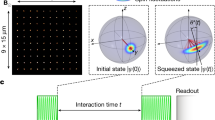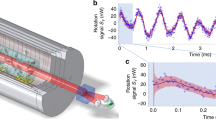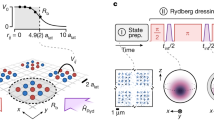Abstract
The measurement sensitivity of quantum probes using N uncorrelated particles is restricted by the standard quantum limit1, which is proportional to \(1/\sqrt{N}\). This limit, however, can be overcome by exploiting quantum entangled states, such as spin-squeezed states2. Here we report the measurement-based generation of a quantum state that exceeds the standard quantum limit for probing the collective spin of 1011 rubidium atoms contained in a macroscopic vapour cell. The state is prepared and verified by sequences of stroboscopic quantum non-demolition (QND) measurements. We then apply the theory of past quantum states3,4 to obtain spin state information from the outcomes of both earlier and later QND measurements. Rather than establishing a physically squeezed state in the laboratory, the past quantum state represents the combined system information from these prediction and retrodiction measurements. This information is equivalent to a noise reduction of 5.6 decibels and a metrologically relevant squeezing of 4.5 decibels relative to the coherent spin state. The past quantum state yields tighter constraints on the spin component than those obtained by conventional QND measurements. Our measurement uses 1,000 times more atoms than previous squeezing experiments5,6,7,8,9,10, with a corresponding angular variance of the squeezed collective spin of 4.6 × 10−13 radians squared. Although this work is rooted in the foundational theory of quantum measurements, it may find practical use in quantum metrology and quantum parameter estimation, as we demonstrate by applying our protocol to quantum enhanced atomic magnetometry.
This is a preview of subscription content, access via your institution
Access options
Access Nature and 54 other Nature Portfolio journals
Get Nature+, our best-value online-access subscription
$29.99 / 30 days
cancel any time
Subscribe to this journal
Receive 51 print issues and online access
$199.00 per year
only $3.90 per issue
Buy this article
- Purchase on Springer Link
- Instant access to full article PDF
Prices may be subject to local taxes which are calculated during checkout




Similar content being viewed by others
Data availability
The datasets generated and analysed during this study are available from the corresponding authors upon reasonable request.
References
Giovannetti, V., Lloyd, S. & Maccone, L. Advances in quantum metrology. Nat. Photon. 5, 222–229 (2011).
Wiseman. H. M & Milburn, G. Quantum Measurement and Control (Cambridge Univ. Press, 2010).
Gammelmark, S., Julsgaard, B. & Mølmer, K. Past quantum states of a monitored system. Phys. Rev. Lett. 111, 160401 (2013).
Zhang, J. & Mølmer, K. Prediction and retrodiction with continuously monitored Gaussian states. Phys. Rev. A 96, 062131 (2017).
Hosten, O., Engelsen, N. J., Krishnakumar, R. & Kasevich, M. A. Measurement noise 100 times lower than the quantum-projection limit using entangled atoms. Nature 529, 505–508 (2016).
Cox, K. C., Greve, G. P., Weiner, J. M. & Thompson, J. K. Deterministic squeezed states with collective measurements and feedback. Phys. Rev. Lett. 116, 093602 (2016).
Appel, J. et al. Mesoscopic atomic entanglement for precision measurements beyond the standard quantum limit. Proc. Natl Acad. Sci. USA 106, 10960–10965 (2009).
Schleier-Smith, M. H., Leroux, I. D. & Vuletić, V. States of an ensemble of two-level atoms with reduced quantum uncertainty. Phys. Rev. Lett. 104, 073604 (2010).
Chaudhury, S. et al. Quantum control of the hyperfine spin of a Cs atom ensemble. Phys. Rev. Lett. 99, 163002 (2007).
Vasilakis, G. et al. Generation of a squeezed state of an oscillator by stroboscopic back-action-evading measurement. Nat. Phys. 11, 389–392 (2015).
Mølmer, K. & Madsen, L. B. Estimation of a classical parameter with Gaussian probes: magnetometry with collective atomic spins. Phys. Rev. A 70, 052102 (2004).
Aharonov, Y., Albert, D. Z. & Vaidman, L. How the result of a measurement of a component of the spin of a spin-1/2 particle can turn out to be 100. Phys. Rev. Lett. 60, 1351 (1988).
Aharonov, Y. & Vaidman, L. Properties of a quantum system during the time interval between two measurements. Phys. Rev. A 41, 11–20 (1990).
Aharonov, Y. & Vaidman, L. Complete description of a quantum system at a given time. J. Phys. A 24, 2315–2328 (1991).
Rybarczyk, T. et al. Forward-backward analysis of the photon-number evolution in a cavity. Phys. Rev. A 91, 062116 (2015).
Tan, D., Weber, S. J., Siddiqi, I., Mølmer, K. & Murch, K. W. Prediction and retrodiction for a continuously monitored superconducting qubit. Phys. Rev. Lett. 114, 090403 (2015).
Rossi, M., Mason, D., Chen, J. & Schliesser, A. Observing and verifying the quantum trajectory of a mechanical resonator. Phys. Rev. Lett. 123, 163601 (2019).
Shah, V., Vasilakis, G. & Romalis, M. V. High bandwidth atomic magnetometery with continuous quantum nondemolition measurements. Phys. Rev. Lett. 104, 013601 (2010).
Wasilewski, W. et al. Quantum noise limited and entanglement-assisted magnetometry. Phys. Rev. Lett. 104, 133601 (2010).
Martin Ciurana, F., Colangelo, G., Slodička, L., Sewell, R. J. & Mitchell, M. W. Entanglement-enhanced radio-frequency field detection and waveform sensing. Phys. Rev. Lett. 119, 043603 (2017).
Smiciklas, M., Brown, J. M., Cheuk, L. W., Smullin, S. J. & Romalis, M. V. New test of local Lorentz invariance using a 21Ne-Rb-K comagnetometer. Phys. Rev. Lett. 107, 171604 (2011).
Bear, D., Stoner, R. E., Walsworth, R. L., Kostelecky, V. A. & Lane, C. D. Limit on Lorentz and CPT violation of the neutron using a two-species noble-gas maser. Phys. Rev. Lett. 85, 5038 (2000).
Khalili, F. Ya. & Polzik, E. S. Overcoming the standard quantum limit in gravitational wave detectors using spin systems with a negative effective mass. Phys. Rev. Lett. 121, 031101 (2018).
Kong, J., Jiménez-Martínez, J., Troullinou, C., Lucivero, V. G. & Mitchell, M. W. Measurement-induced nonlocal entanglement in a hot, strongly-interacting atomic system. Preprint at http://arXiv.org/quant-ph/1804.07818 (2018).
Hammerer, K., Sørensen, A. S. & Polzik, E. S. Quantum interface between light and atomic ensembles. Rev. Mod. Phys. 82, 1041–1093 (2010).
Balabas, M. V., Karaulanov, T., Ledbetter, M. P. & Budker, D. Polarized alkali-metal vapor with minute-long transverse spin-relaxation time. Phys. Rev. Lett. 105, 070801 (2010).
Wineland, D. J., Bollinger, J. J., Itano, W. M. & Heinzen, D. J. Squeezed atomic states and projection noise in spectroscopy. Phys. Rev. A 50, 67 (1994).
Borregaard, J. & Sorensen, A. S. Near-Heisenberg-limited atomic clocks in the presence of decoherence. Phys. Rev. Lett. 111, 090801 (2013).
Braverman, B. et al. Near-unitary spin squeezing in Yb-171. Phys. Rev. Lett. 122, 223203 (2019).
Wang, M. F. et al. Two-axis-twisting spin squeezing by multipass quantum erasure. Phys. Rev. A 96, 013823 (2017).
Takeuchi, M. et al. Spin squeezing via one-axis twisting with coherent light. Phys. Rev. Lett. 94, 023003 (2005).
Tsang, M. Time-symmetric quantum theory of smoothing. Phys. Rev. Lett. 102, 250403 (2009).
Aspelmeyer, M., Kippenberg, T. J. & Marquardt, F. Cavity optomechanics. Rev. Mod. Phys. 86, 1391–1452 (2014).
Bell, W. E. & Bloom, A. L. Optically driven spin precession. Phys. Rev. Lett. 6, 280–281 (1961).
Shen, H. Spin Squeezing and Entanglement with Room Temperature Atoms for Quantum Sensing and Communication. PhD thesis, Univ. of Copenhagen (2015).
Julsgaard, B., Sherson, J., Sørensen, J. L. & Polzik, E. S. Characterizing the spin state of an atomic ensemble using the magneto-optical resonance method. J. Opt. B 6, 5–14 (2004).
Yonezawa, H. et al. Quantum-enhanced optical-phase tracking. Science 337, 1514–1517 (2012).
Huelga, S. F. et al. Improvement of frequency standards with quantum entanglement. Phys. Rev. Lett. 79, 3865–3868 (1997).
André, A., Sørensen, A. S. & Lukin, M. D. Stability of atomic clocks based on entangled atoms. Phys. Rev. Lett. 92, 230801 (2004).
Auzinsh, M. et al. Can a quantum nondemolition measurement improve the sensitivity of an atomic magnetometer? Phys. Rev. Lett. 93, 173002 (2004).
Braverman, B., Kawasaki, A. & Vuletić, V. Impact of non-unitary spin squeezing on atomic clock performance. New J. Phys. 20, 103019 (2018).
Budker, D. & Kimball, D. F. J. Optical Magnetometry (Cambridge Univ. Press, 2013).
Kominis, I. K., Kornack, T. W., Allred, J. C. & Romalis, M. V. A subfemtotesla multichannel atomic magnetometer. Nature 422, 596 (2003).
Jensen, K. Quantum Information, Entanglement and Magnetometry with Macroscopic Gas Samples and Non-Classical Light. PhD thesis, Univ. of Copenhagen (2011).
Acknowledgements
We thank M. Balabas for assistance in the vapour cell fabrication and V. Vuletić for discussions. This work is supported by the National Key Research Program of China under grants 2016YFA0302000 and 2017YFA0304204, and the NNSFC under grants 61675047 and 91636107. K.M. acknowledges support from the Villum Foundation. H.S. acknowledges financial support from a UK Royal Society Newton International Fellowship (NF170876).
Author information
Authors and Affiliations
Contributions
K.M., H.S. and Y.X. conceived the idea. H.B., J.D., S.J., X.L., P.L., I.N., E.E.M., H.S. and Y.X. designed the experiment, performed the measurements and analysed the data together with all other authors. K.-F.Z. helped with the fabrication and characterization of vapour cells. H.B., M.W. and H.S. carried out the theoretical analysis under K.M.’s supervision. H.B., H.S., K.M. and Y.X. wrote the manuscript with contributions from all other authors. H.S. and Y.X. supervised the project.
Corresponding authors
Ethics declarations
Competing interests
The authors declare no competing interests.
Additional information
Peer review information Nature thanks Julian Martinez-Rincon and the other, anonymous, reviewer(s) for their contribution to the peer review of this work.
Publisher’s note Springer Nature remains neutral with regard to jurisdictional claims in published maps and institutional affiliations.
Extended data figures and tables
Extended Data Fig. 1 Magneto-optical resonance signal.
a, Spin response to an RF pulse. X and Y are the outputs of the lock-in amplifier, with a π/2 phase difference between them. \(R=\sqrt{{X}^{2}+{Y}^{2}}\) is the demodulated amplitude. b, The associated Fourier transformation of the spin response signal. fLar is the centre frequency for demodulation, with the subscript ‘Lar’ representing ‘Larmor frequency’. f is the actual frequency of the signal before demodulation. f − fLar represents the frequency of the signal after demodulation, that is, at the lock-in amplifier output. Inset, energy levels of 87Rb. All the atoms are pumped into the F = 2, mF = −2 state, so that they are oriented along x. The magnetic field leads to a splitting of the magnetic sublevels by the Larmor frequency ΩL. A.U., arbitrary units.
Extended Data Fig. 2 Measured photon shot noise with different probe powers.
Red circles are experimental data and the dashed line represents the linear fit of the data. PSN, photon shot noise.
Extended Data Fig. 3 Spin noise versus atom number.
a, Effective coupling constant \({\tilde{\kappa }}^{2}\) as a function of the number of atoms. The values of \({\tilde{\kappa }}^{2}\) are derived from the spin noise of the thermal state. b, Spin noise of prepared CSS versus the number of atoms. The observed linear dependence proves that technical noise is mostly suppressed and the measured spin noise is at the projection noise limit (PNL).
Extended Data Fig. 4 Calibration of the applied RF magnetic field.
a, Calibration using the displacement of atomic spins. b, Calibration using a small pickup coil. The amplitude of the RF output in our detection experiment is −97 dB m, which lies at the bottom left of the figure. In both curves, a slope near 1 indicates a good linear relation.
Supplementary information
Supplementary Information
This file contains Supplementary Information for Squeezed spin of 10^11 atoms by prediction and retrodiction measurements. The file includes the experimental detail and details on theory.
Rights and permissions
About this article
Cite this article
Bao, H., Duan, J., Jin, S. et al. Spin squeezing of 1011 atoms by prediction and retrodiction measurements. Nature 581, 159–163 (2020). https://doi.org/10.1038/s41586-020-2243-7
Received:
Accepted:
Published:
Issue Date:
DOI: https://doi.org/10.1038/s41586-020-2243-7
This article is cited by
-
Acoustic frequency atomic spin oscillator in the quantum regime
Nature Communications (2023)
-
Quantum-enhanced sensing by echoing spin-nematic squeezing in atomic Bose–Einstein condensate
Nature Physics (2023)
-
High-performance cavity-enhanced quantum memory with warm atomic cell
Nature Communications (2022)
-
Time-reversal-based quantum metrology with many-body entangled states
Nature Physics (2022)
-
Nonlinear interferometry beyond classical limit enabled by cyclic dynamics
Nature Physics (2022)
Comments
By submitting a comment you agree to abide by our Terms and Community Guidelines. If you find something abusive or that does not comply with our terms or guidelines please flag it as inappropriate.



